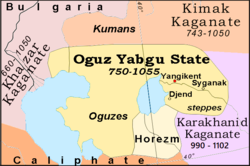This article needs additional citations for verification. (October 2010) |
Oghuz Yabgu State | |||||||||||||
|---|---|---|---|---|---|---|---|---|---|---|---|---|---|
| 766–1055 | |||||||||||||
 Oghuz Yabgu State, 750–1055 | |||||||||||||
| Status | Khaganate | ||||||||||||
| Capital | Yangikent | ||||||||||||
| Common languages | Turkic | ||||||||||||
| Ethnic groups | Oghuzes, Kumans, Kangars, Turgeshes | ||||||||||||
| Religion | Tengriism | ||||||||||||
| Historical era | 8th–11th centuries | ||||||||||||
• Established | 766 | ||||||||||||
• Disestablished | 1055 | ||||||||||||
| |||||||||||||
| Today part of | |||||||||||||
| History of the Turkic peoples pre–14th century |
|---|
 |
The Oghuz Yabgu State or Oghuz ili (Old Turkic: Land of Oghuz) was a Turkic state, founded by Oghuz Turks in 766, located geographically in an area between the coasts of the Caspian and Aral Seas. Oghuz tribes occupied a vast territory in Kazakhstan along the Irgiz, Yaik, Emba, and Uil rivers, the Aral Sea area, the Syr Darya valley, the foothills of the Karatau Mountains in Tien-Shan, and the Chui River valley (see map). The Oghuz political association developed in the 9th and 10th centuries in the basin of the middle and lower course of the Syr Darya and adjoining the modern western Kazakhstan steppes.